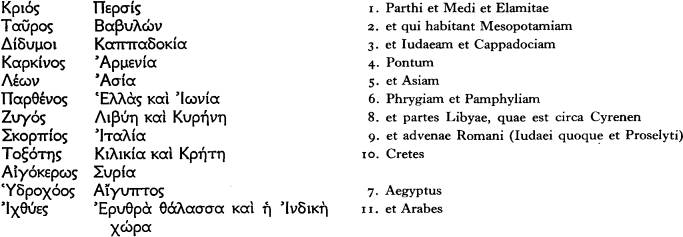Article contents
The Geographical Catalogue in Acts II, 9–11
Published online by Cambridge University Press: 24 September 2012
Extract
If this note should prove persuasive, the credit will not belong to me; if not, I must accept the blame for publishing something not published by its author.
Recently I acquired an offprint of Cumont's article ‘La plus ancienne géographie astrologique’ (Klio ix, 1909, 263–273) which deals with the doctrine that divides up the various countries among the signs of the zodiac. On p. 265, where the list of Paulus Alexandrinus (which I reproduce below in the left column) is given, I found a marginal note (here on the right) in the hand of the late Professor F. C. Burkitt:—

Burkitt's opinion obviously was that, if we want to understand this list of the Acts, we must turn to astrological geography. This seemed a convincing suggestion and became even more convincing when I found how this passage had puzzled the commentators. Some of them felt that the writer meant to say ‘the whole oecumene’, but they could not explain why he mentions just these countries. What follows is intended to show that Burkitt's suggestion is sound.
- Type
- Research Article
- Information
- Copyright
- Copyright © Stefan Weinstock 1948. Exclusive Licence to Publish: The Society for the Promotion of Roman Studies
References
1 I am indebted to Professor C. H. Dodd and the Very Rev. John Lowe for valuable guidance in biblical matters.
2 The identity of the hand is established through some of Professor Burkitt's letters, kindly made available to me by Professor Dodd and Mr. K. Sisam. A difficulty still remains: a conjecture of Burkitt's (Гορδυαίαν for Ίουδαίαν) appears in Nestle's app. crit. from 1927 onwards. I am unable to find out if it was ever published and if it was, where and when; if before 1909, it would not matter; if after, he either forgot or discarded his idea. It is particularly puzzling that Burkitt did not comment on this conjecture when mentioned again in Jackson-Lake's Beginnings of Christianity, although he read this work in proof.
3 I have consulted the commentaries of Knowling, Wendt, Zahn, Jackson-Lake, and Bauernfeind; in addition, Harnack, Apostelgesch. 65 ff., and Behm, , Theol. Wörterb. z. NT. i, 724Google Scholar.
4 Cf. Bouché-Leclercq, Astrol. gr. 328 ff.; Cumont, l.c.; Boll-Bezold, Sternglaube u. Sterndeutung 3 9; 64; 157; Kroll, P-W xvii, 1882.
5 Cf. e.g. Deuteron. iv, 19: ἰδὼν τὸν ἥλιον καὶ τὴν σελήνην καὶ τοὺς ἀστέρας and Boll, P-W Suppl. iv, 656 n.
6 A similar primitive map is described by Ps. Hippocr. de hebd. II and ridiculed by Aristophanes (Equ. 75 ff.): the head of the earth is the Peloponnese, its neck the Isthmus, its diaphragm Ionia, its thigh the Hellespont, etc.; cf. Kranz, Nachr. Gött. Ges. 1938, 138 ff., 149.
7 Cf. e.g. Manil. iv, 744 ff. (Housman, Introd. pp. xii ff.); Ptol., Tetrab. ii, 3 f.Google Scholar, and above n. 4.
8 Paul. Alex. fol. A 2 ff. (ed. Schato, 1586); the list further appears in various excerpts: Boll, Sphaera 296; Ludwich, Maximus et Ammo 112 ff.; Catal. codd. astrol. vii, 194 ff.; cf. iv, 126 n.; a fragment of the fuller list in Vett. Val. i, 2, p. 12 Kr.; cf. Cumont, l.c. 268.
9 Cf. Boll, Sphaera 296; Cumont, l.c. 270.
10 See above, note 8.
11 Burkitt ap. Cumont 273; cf. A. Bentzen, Daniel 37.
12 It may be that Euripides too used, however freely, this map in describing the conquest of the world by Dionysus, Bacch. 13 ff. (c. 407 B.C.). He would then be the earliest witness, and, incidentally, it would no longer be necessary to assume that all countries mentioned by Euripides had an early cult of Dionysus.
13 In the following I owe to Cumont (l.c.) the observation that Virgo, Libra, and Sagittarius each contain a free country coupled with a satrapy; that Egypt, so often inundated, well suits Aquarius; and that Pisces are in their element in the Red Sea.
14 Cf. Boll, , Aus der Offenbarung Johannis 47, 1Google Scholar.
15 Soden quotes a minuscule MS. with καὶ Ἴνδοι after ״Αραβς: probably an intelligent addition of the scribe and not the original reading of the Acts.
16 Cf. Strack-Billerbeck, , Kommentar z. NT. aus Talmud u. Midrasch ii, 605Google Scholar; iii, 48 f.; 194; Enoch 89, 59; F. Spitta, Die Apostelgeschichte … 1891, 27 f.; Lake, , Beginnings of Christianity v, 115 fGoogle Scholar.
17 Cf. Bidez-Cumont, , Les Mages hellénisés i, 40Google Scholar; ii, 101; 104; 131 f.
18 One could compare Enoch 77, 4 ff., where the geographical setting (seven mountains, seven rivers, seven islands) is Persian and not, as it should be, Jewish: see Bousset, Religion des Judentums 3 499.
19 After I had written this note I found that Halévy, J. (T'oung Pao, NS. vii, Leiden, 1906, 279–281Google Scholar) was the first to see the correspondence between the two lists. His contention, however, that the priority belongs to the list of the Acts, excerpted later by a Christian astrologer, was rightly, I think, rejected by Boll, ibid, xiii, 1912, 715. The astonishing thing is that Boll did not realize the value of Halévy's discovery in its corrected form. Burkitt made his discovery, I believe, independently.
- 3
- Cited by


